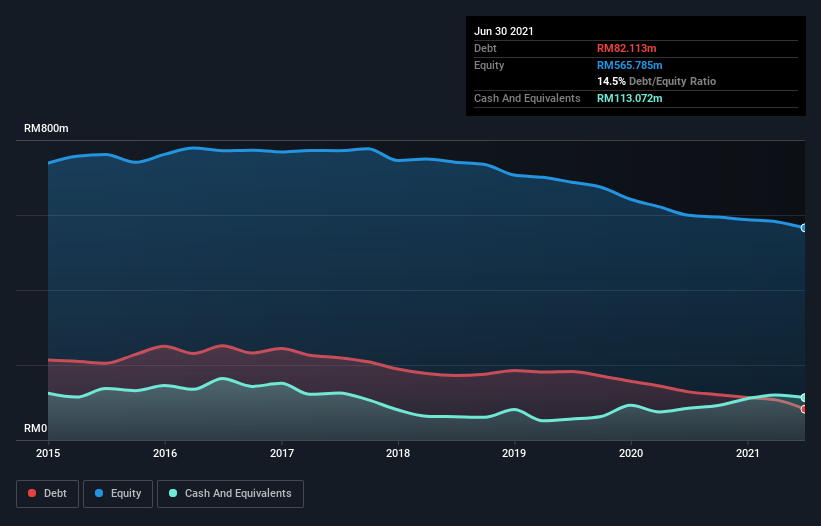Health Check: How Prudently Does White Horse Berhad (KLSE:WTHORSE) Use Debt?

Some say volatility, rather than debt, is the best way to think about risk as an investor, but Warren Buffett famously said that 'Volatility is far from synonymous with risk.' When we think about how risky a company is, we always like to look at its use of debt, since debt overload can lead to ruin. We note that White Horse Berhad (KLSE:WTHORSE) does have debt on its balance sheet. But should shareholders be worried about its use of debt?
When Is Debt Dangerous?
Debt is a tool to help businesses grow, but if a business is incapable of paying off its lenders, then it exists at their mercy. Ultimately, if the company can't fulfill its legal obligations to repay debt, shareholders could walk away with nothing. However, a more common (but still painful) scenario is that it has to raise new equity capital at a low price, thus permanently diluting shareholders. Having said that, the most common situation is where a company manages its debt reasonably well - and to its own advantage. The first thing to do when considering how much debt a business uses is to look at its cash and debt together.
See our latest analysis for White Horse Berhad
How Much Debt Does White Horse Berhad Carry?
The image below, which you can click on for greater detail, shows that White Horse Berhad had debt of RM82.1m at the end of June 2021, a reduction from RM128.3m over a year. But it also has RM113.1m in cash to offset that, meaning it has RM31.0m net cash.

How Healthy Is White Horse Berhad's Balance Sheet?
According to the last reported balance sheet, White Horse Berhad had liabilities of RM171.5m due within 12 months, and liabilities of RM29.1m due beyond 12 months. On the other hand, it had cash of RM113.1m and RM82.2m worth of receivables due within a year. So its liabilities total RM5.30m more than the combination of its cash and short-term receivables.
Since publicly traded White Horse Berhad shares are worth a total of RM158.8m, it seems unlikely that this level of liabilities would be a major threat. However, we do think it is worth keeping an eye on its balance sheet strength, as it may change over time. Despite its noteworthy liabilities, White Horse Berhad boasts net cash, so it's fair to say it does not have a heavy debt load! When analysing debt levels, the balance sheet is the obvious place to start. But it is White Horse Berhad's earnings that will influence how the balance sheet holds up in the future. So if you're keen to discover more about its earnings, it might be worth checking out this graph of its long term earnings trend.
In the last year White Horse Berhad wasn't profitable at an EBIT level, but managed to grow its revenue by 7.3%, to RM453m. We usually like to see faster growth from unprofitable companies, but each to their own.
So How Risky Is White Horse Berhad?
Although White Horse Berhad had an earnings before interest and tax (EBIT) loss over the last twelve months, it generated positive free cash flow of RM78m. So taking that on face value, and considering the net cash situation, we don't think that the stock is too risky in the near term. With revenue growth uninspiring, we'd really need to see some positive EBIT before mustering much enthusiasm for this business. There's no doubt that we learn most about debt from the balance sheet. However, not all investment risk resides within the balance sheet - far from it. These risks can be hard to spot. Every company has them, and we've spotted 2 warning signs for White Horse Berhad (of which 1 is significant!) you should know about.
At the end of the day, it's often better to focus on companies that are free from net debt. You can access our special list of such companies (all with a track record of profit growth). It's free.
Valuation is complex, but we're here to simplify it.
Discover if White Horse Berhad might be undervalued or overvalued with our detailed analysis, featuring fair value estimates, potential risks, dividends, insider trades, and its financial condition.
Access Free AnalysisThis article by Simply Wall St is general in nature. We provide commentary based on historical data and analyst forecasts only using an unbiased methodology and our articles are not intended to be financial advice. It does not constitute a recommendation to buy or sell any stock, and does not take account of your objectives, or your financial situation. We aim to bring you long-term focused analysis driven by fundamental data. Note that our analysis may not factor in the latest price-sensitive company announcements or qualitative material. Simply Wall St has no position in any stocks mentioned.
Have feedback on this article? Concerned about the content? Get in touch with us directly. Alternatively, email editorial-team (at) simplywallst.com.
About KLSE:WTHORSE
White Horse Berhad
An investment holding company, engages in the manufacture and distribution of ceramic and homogeneous tiles in Malaysia, Vietnam, Indonesia, the Philippines, Singapore, Thailand, and China.
Flawless balance sheet and slightly overvalued.
Market Insights
Community Narratives




